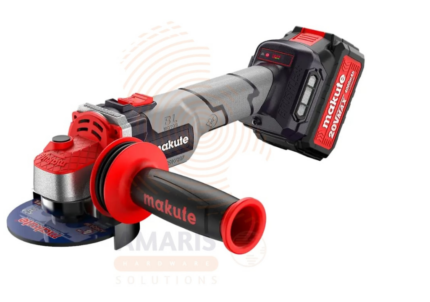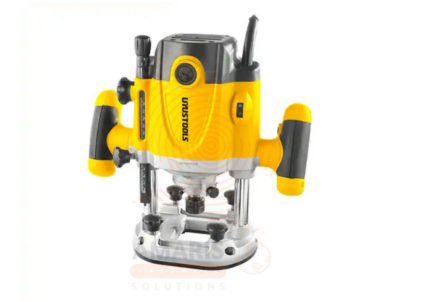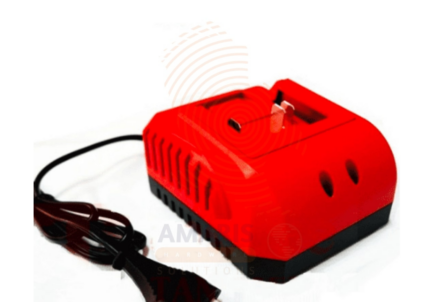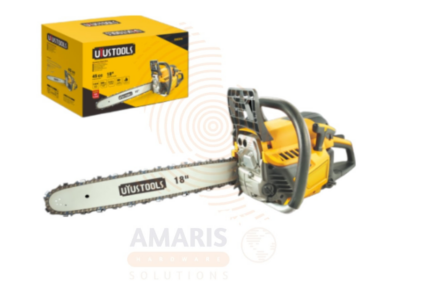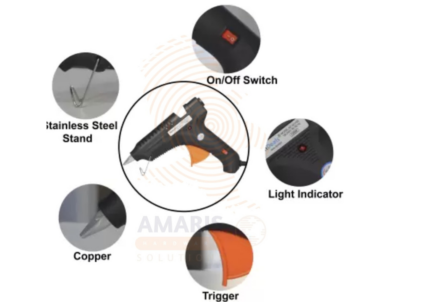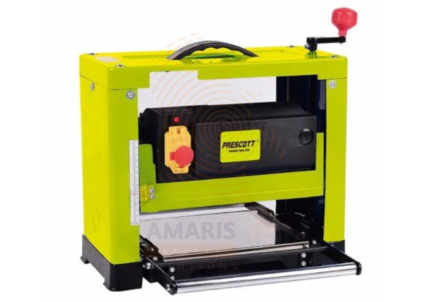

Thickness Planner Blade
$20.77 Original price was: $20.77.$19.73Current price is: $19.73.
A Thickness Planner Blade is a cutting tool specifically designed for use in a thickness planer machine. The thickness planer is a woodworking tool used to reduce the thickness of a work piece, such as a board or plank, by consistently shaving off thin layers of material. The planer blade, often made of high-speed steel or carbide, is a sharp and durable cutting edge that rotates at high speeds within the planer. Its primary function is to remove excess material from the surface of the work piece, resulting in a smooth and uniform thickness across the entire piece. The quality and sharpness of the thickness planer blade significantly impact the precision and finish of the planed surface.
Table of Contents
ToggleThickness Planner Blade
Uses
-
Material Thickness Reduction:
-
The primary purpose of a thickness planer blade is to reduce the thickness of a wooden work piece. By feeding the material through the planer, the blade removes thin layers, providing a consistent and smooth surface.
-
-
Surface Smoothing:
-
Thickness planers are effective in smoothing rough surfaces and eliminating imperfections, such as unevenness, snipe, or rough saw marks. The blade plays a key role in achieving a polished and even finish.
-
-
Dimensional Consistency:
-
Woodworkers use thickness planers to ensure uniform thickness across a board or plank. This is particularly important when working on projects that require precise dimensions for a professional and aesthetically pleasing result.
-
-
Creating Parallel Surfaces:
-
Thickness planers are essential for creating parallel surfaces on wooden pieces. This is important for joinery work, where two or more pieces need to fit together seamlessly.
-
-
Material Cleanup:
-
When working with reclaimed or rough-sawn lumber, a thickness planer is employed to clean up and refine the surfaces. The blade removes any irregularities, knots, or other defects in the material.
-
-
Customizing Stock Thickness:
-
Woodworkers often need to customize the thickness of stock material to meet specific project requirements. The thickness planer blade facilitates this customization by allowing precise adjustments to the material thickness.
-
-
Creating Consistent Panels:
-
In cabinet making and furniture construction, thickness planers are used to create consistent thickness across multiple boards, ensuring that panels or components fit together seamlessly.
-
-
Enhancing Woodworking Efficiency:
-
Using a thickness planer speeds up the woodworking process by quickly and efficiently reducing the thickness of material. This is especially important when dealing with large quantities of lumber.
-
-
Preparing Stock for Further Processing:
-
Before additional woodworking processes, such as joinery, gluing, or shaping, the thickness planer is often used to prepare the stock material, providing a clean and uniform starting point for subsequent work.
-
Safety Precautions
-
Protective Gear:
-
Eye Protection: Always wear safety glasses or goggles to protect your eyes from flying wood chips and debris.
-
Hearing Protection: Use earplugs or earmuffs to protect your hearing when operating the planer.
-
Personal Protective Equipment (PPE): Wear gloves to protect your hands when handling blades, and avoid loose clothing or jewelry that could get caught.
-
Read the Manual:
-
Familiarize yourself with the planer’s user manual, especially the blade installation and maintenance instructions.
-
Blade Handling:
-
Handle blades carefully to avoid cuts; always hold blades by the edges, not the cutting surface.
-
Ensure blades are properly installed, secured, and aligned before operation.
-
Secure Work Area:
-
Keep the workspace clean and well-lit.
-
Remove any obstacles or loose objects near the planer.
-
Power Off Before Maintenance:
-
Always disconnect power before changing or servicing blades.
-
Proper Installation:
-
Use the correct blades specified for your planer model.
-
Verify that blades are sharp and free from damage to prevent kickback or poor cuts.
-
Stable Position:
-
Stand firmly and maintain balance when feeding wood into the planer.
-
Avoid Overreach:
-
Do not reach into the planer while it is running.
-
Ventilation:
-
Work in a well-ventilated area to avoid inhaling wood dust.
-
Emergency Preparedness:
-
Know the location of emergency stops and first aid supplies.


 Acrylic Sealants
Acrylic Sealants Construction Adhesives
Construction Adhesives Double-Sided Tape
Double-Sided Tape Duct Tape
Duct Tape Electrical Tape
Electrical Tape Epoxy & Resins
Epoxy & Resins Masking Tape
Masking Tape
 Automotive Wrenches & Socket Sets
Automotive Wrenches & Socket Sets Battery Chargers & Jump Starters
Battery Chargers & Jump Starters Car Jacks & Stands
Car Jacks & Stands Car Wash & Detailing Products
Car Wash & Detailing Products Diagnostic Tools
Diagnostic Tools Tire Inflators
Tire Inflators Vehicle Lighting
Vehicle Lighting Oil & Lubricants
Oil & Lubricants
 Adhesives & Sealants
Adhesives & Sealants Bricks & Blocks
Bricks & Blocks Cement & Concrete
Cement & Concrete Drywall & Plaster
Drywall & Plaster Flooring (Tiles, Wood, Laminate)
Flooring (Tiles, Wood, Laminate) Lumber & Plywood
Lumber & Plywood Paints, Primers & Coatings
Paints, Primers & Coatings Insulation Materials
Insulation Materials Roofing Materials
Roofing Materials
 Circuit Breakers
Circuit Breakers Electrical Cables & Wires
Electrical Cables & Wires Switches & Sockets
Switches & Sockets Fuses & Relays
Fuses & Relays Connectors & Terminals
Connectors & Terminals Electrical Boxes & Panels
Electrical Boxes & Panels Conduit & Fittings
Conduit & Fittings Lighting Fixtures & Bulbs
Lighting Fixtures & Bulbs Extension Cords & Power Strips
Extension Cords & Power Strips
 Anchors
Anchors Bolts
Bolts Clips & Clamps
Clips & Clamps Screws
Screws Nuts
Nuts Washers
Washers Rivets
Rivets Nails
Nails Threaded Rods
Threaded Rods
 Hammers
Hammers Measuring Tools (Tapes, Levels, Calipers)
Measuring Tools (Tapes, Levels, Calipers) Screwdrivers
Screwdrivers Pliers & Cutters
Pliers & Cutters Saws & Blades
Saws & Blades Chisels & Punches
Chisels & Punches Allen Keys & Hex Keys
Allen Keys & Hex Keys Ratchets & Socket Sets
Ratchets & Socket Sets Wrenches & Spanners
Wrenches & Spanners
 Power Tool Accessories (Blades, Bits, Discs)
Power Tool Accessories (Blades, Bits, Discs) Rotary Tools
Rotary Tools Saws (Circular, Jigsaw, Reciprocating)
Saws (Circular, Jigsaw, Reciprocating) Drills & Drivers
Drills & Drivers Grinders & Sanders
Grinders & Sanders Heat Guns
Heat Guns Nail Guns
Nail Guns Impact Wrenches
Impact Wrenches Batteries & Chargers
Batteries & Chargers
 Pipes & Fittings (PVC, Copper, PEX)
Pipes & Fittings (PVC, Copper, PEX) Plumbing Tools
Plumbing Tools Pumps & Motors
Pumps & Motors Sealants & Adhesives for Plumbing
Sealants & Adhesives for Plumbing Valves & Taps
Valves & Taps Water Heaters
Water Heaters Drainage Systems
Drainage Systems Faucets & Fixtures
Faucets & Fixtures Hoses & Tubing
Hoses & Tubing
 Hinges & Latches
Hinges & Latches Hooks & Brackets
Hooks & Brackets Window Hardware
Window Hardware Chains & Cables
Chains & Cables Casters & Wheels
Casters & Wheels Shelving & Storage Systems
Shelving & Storage Systems Door Handles & Locks
Door Handles & Locks Drawer Slides & Cabinet Hardware
Drawer Slides & Cabinet Hardware
 Personal Protective Equipment (PPE)
Personal Protective Equipment (PPE) Respirators & Masks
Respirators & Masks Safety Glasses
Safety Glasses Safes
Safes Security Cameras
Security Cameras Gloves
Gloves Helmets
Helmets Ear Protection
Ear Protection Fire Safety Equipment
Fire Safety Equipment Locks & Padlocks
Locks & Padlocks Motion Sensors & Alarms
Motion Sensors & Alarms
 Garden Fencing
Garden Fencing Garden Furniture Hardware
Garden Furniture Hardware Lawn Mowers
Lawn Mowers Trimmers & Edgers
Trimmers & Edgers Shovels & Spades
Shovels & Spades Rakes & Hoes
Rakes & Hoes Pruning Shears & Loppers
Pruning Shears & Loppers Watering Systems (Hoses, Sprinklers, Nozzles)
Watering Systems (Hoses, Sprinklers, Nozzles)
 Interior Paints
Interior Paints Paint Brushes & Rollers
Paint Brushes & Rollers Paint Strippers & Thinners
Paint Strippers & Thinners Paint Trays & Accessories
Paint Trays & Accessories Exterior Paints
Exterior Paints Spray Paints
Spray Paints Primers & Undercoats
Primers & Undercoats Varnishes & Stains
Varnishes & Stains
 Gaskets & Seals
Gaskets & Seals Hydraulic Fittings
Hydraulic Fittings Industrial Fasteners
Industrial Fasteners Industrial Hoses
Industrial Hoses Lubricants & Greases
Lubricants & Greases Metal Sheets & Bars
Metal Sheets & Bars Bearings & Bushings
Bearings & Bushings Belts & Pulleys
Belts & Pulleys
 HVAC Filters
HVAC Filters Insulation for HVAC
Insulation for HVAC Air Conditioners
Air Conditioners Refrigerants
Refrigerants Ventilation Ducts & Fittings
Ventilation Ducts & Fittings Thermostats & Controllers
Thermostats & Controllers Fans & Blowers
Fans & Blowers
 Pegboards & Hooks
Pegboards & Hooks Shelving Units
Shelving Units Storage Bins & Containers
Storage Bins & Containers Toolboxes & Tool Chests
Toolboxes & Tool Chests Workbenches
Workbenches Drawer Organizers
Drawer Organizers Labeling Supplies
Labeling Supplies
 Welding Accessories (Clamps, Brushes)
Welding Accessories (Clamps, Brushes) Welding Electrodes & Rods
Welding Electrodes & Rods Welding Helmets & Gloves
Welding Helmets & Gloves Welding Machines
Welding Machines Soldering Irons & Stations
Soldering Irons & Stations Flux & Solder Wire
Flux & Solder Wire
 Generator Accessories
Generator Accessories Inverters
Inverters Portable Generators
Portable Generators Power Inverters
Power Inverters Transfer Switches
Transfer Switches Diesel & Gasoline Generators
Diesel & Gasoline Generators
 Transport Equipment: Carts, Dollies, and Hand Trucks
Transport Equipment: Carts, Dollies, and Hand Trucks Storage Solutions: Pallets, Racks, and Containers
Storage Solutions: Pallets, Racks, and Containers Lifting Equipment: Hoists, Cranes, and Jacks
Lifting Equipment: Hoists, Cranes, and Jacks Conveyors and Accessories: Belts and Rollers
Conveyors and Accessories: Belts and Rollers

